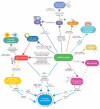Complex Analysis of Single-Cell RNA Sequencing Data
- PMID: 37072324
- PMCID: PMC10000364
- DOI: 10.1134/S0006297923020074
Complex Analysis of Single-Cell RNA Sequencing Data
Abstract
Single-cell RNA sequencing (scRNA-seq) is a revolutionary tool for studying the physiology of normal and pathologically altered tissues. This approach provides information about molecular features (gene expression, mutations, chromatin accessibility, etc.) of cells, opens up the possibility to analyze the trajectories/phylogeny of cell differentiation and cell-cell interactions, and helps in discovery of new cell types and previously unexplored processes. From a clinical point of view, scRNA-seq facilitates deeper and more detailed analysis of molecular mechanisms of diseases and serves as a basis for the development of new preventive, diagnostic, and therapeutic strategies. The review describes different approaches to the analysis of scRNA-seq data, discusses the advantages and disadvantages of bioinformatics tools, provides recommendations and examples of their successful use, and suggests potential directions for improvement. We also emphasize the need for creating new protocols, including multiomics ones, for the preparation of DNA/RNA libraries of single cells with the purpose of more complete understanding of individual cells.
Keywords: cell cycle; cell type; cell–cell interaction; clustering; copy number variation; differential expression; epigenomics; gene regulatory network; phylogenetics; single nucleotide variant; single-cell RNA sequencing; spatial transcriptomics; trajectory inference.
Conflict of interest statement
The authors declare no conflicts of interest in financial or any other sphere. This article does not contain description of studies with human participants or animals performed by any of the authors.
Figures
References
Publication types
MeSH terms
Substances
LinkOut - more resources
Full Text Sources



